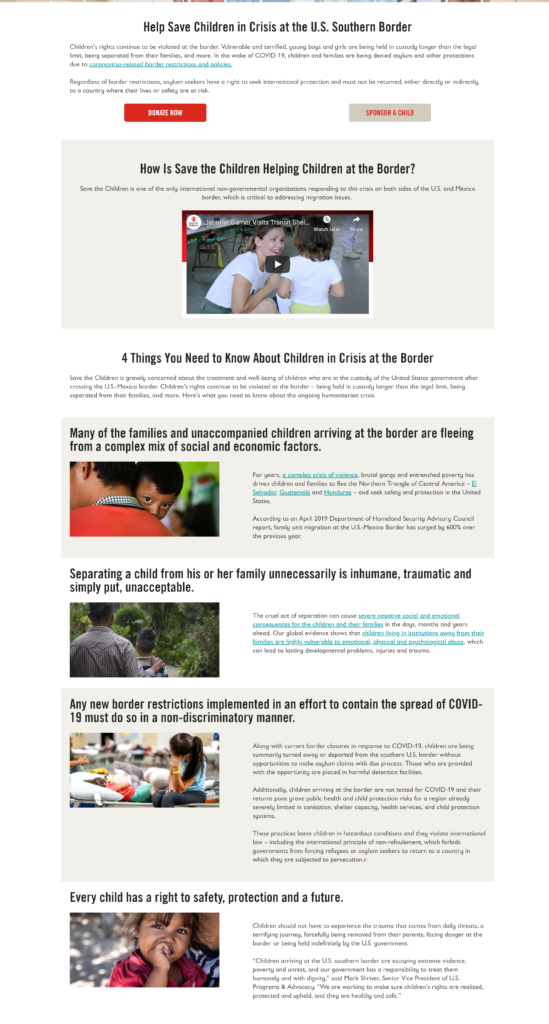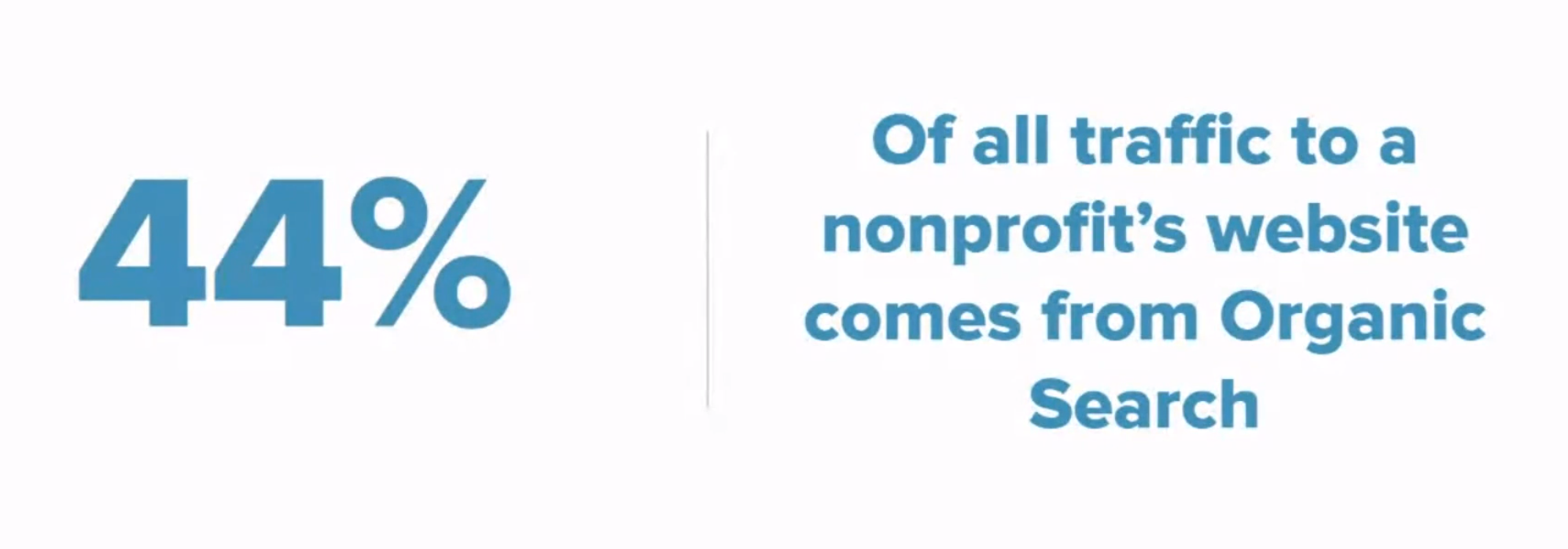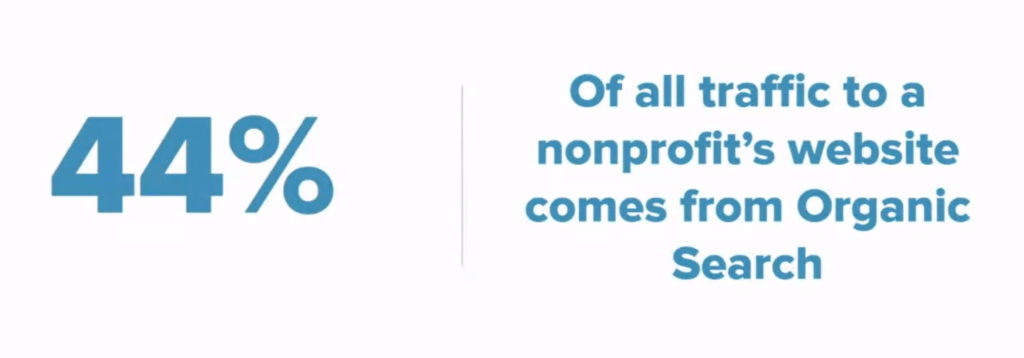Karen Hopper, Senior Digital Strategist at M+R, is no stranger to building relationships with organic visitors. Her agency focuses on serving nonprofit clients through both marketing and fundraising channels. Due to nonprofits’ public service role, organic is a major channel for incoming clients, donors, and information seekers. At Found Conference, Karen spoke on the unique relationship between organic visitors and nonprofits. But, relationship-building is vitally important for nearly all orgs — even those in the private sector. How can you build relationships with organic users — and keep them coming back?
Is organic still relevant? Consider your information-seekers.
Because paid advertising is such a huge part of most orgs’ budgets, marketing can feel like a pay-to-win game. However, organic strategy is still a key component of user outreach — especially new user outreach.
M+R performed a benchmark study in 2020 looking at more than 200 non-profit websites. On the sites surveyed, 44 percent of all traffic came from organic search. For some groups, this percentage was even higher:
- Healthcare and animal welfare-based sites received more than half of their traffic through organic, possibly because they provide sought-for information like “how to help a loved one with cancer” or “how to adopt a shelter animal.
- For small and local organizations, organic is even more important, comprising well over half of incoming traffic. Consider “food banks in Toledo” or “animal shelter Flagstaff” as potential search terms: the relevant orgs may not have branded name recognition. But, people are searching for the services they provide.
M+R found that, while organic users make up a good chunk of traffic for nonprofits, they may not participate in one important conversion: fundraising. Building out donors is a primary goal of many nonprofits, so donations are an important conversion to track. In M+R’s study, only 0.17 percent of organic visitors make a donation in the same session, meaning that orgs collected about 30 cents per organic visitor.
Is fundraising a valid goal for organic search?
As content strategists, we’re all striving for a balance between visitor intent and organizational goals. In a dream world, every organization would work together toward perfectly-aligned goals, hold regular meetings, and assign a content strategist to drive the organization toward better content marketing. But, in the hectic nonprofit world — and, especially, the world of small nonprofits — that focus may not exist. Most marketers wear lots of hats, and the organization itself may pivot between various causes and activities.
Internal nonprofit bureaucracy struggles can gum up creation: you may be working with an IT team focused on usability, and program teams may need to justify grant work by publishing content, while development is more focused on cultivating donors and building contact lists. Or, one team may not be comfortable releasing great content to marketers and fundraisers, due to donor or client privacy issues.
These competing priorities can create less-than-perfect content flow, and the result is ineffective, over-sanitized content. This phenomenon works against nonprofits: you want to welcome visitors to your site and offer them engaging, personalized content — not boring and committee- approved generalizations.
So, how can you provide organic users with content that matches their intent — and, how can you go beyond providing that content to create a mutually beneficial relationship? Karen offers three steps to success.
Step 1: Introduce yourself
Karen says that many of the top landing pages she sees for nonprofits fully fail to mention the org that created the page: you’ll see no mention of the organization or its 501(c)3 status, save maybe a logo that disappears once users begin scrolling. This is a huge problem for two reasons. One, Most of your organic search visitors are probably unfamiliar with your org and mission. And, organic visitors may not arrive through the homepage.
In Google Analytics’ Channels report, Karen found that the vast majority of organic traffic coming to her clients’ sites was new-user traffic. Of those new users, between 2 and 15 percent landed on the homepage — that One Page that marketers spend so much time and effort beautifying. The other 85 (or more!) percent of new users experience the organization for the first time on an internal content page — because they’ve queried for information that’s available in an article or post on the site. Remember that, while you want to provide valuable content, you also want to promote yourself — even on internal pages.
Go out of your way to show who you are, what you do, and why you’re a trusted source. If a call to action is part of your campaign, make sure to tell the reader how to learn more, get involved, or donate. Establish yourself as the place to find the info the user is seeking.
Karen shares the example from the nonprofit Save the Children, which discusses issues facing children in custody at the US-Mexico border. This content does so much: it explains the issue in a factual and well-formatted way, links to pages sites and external partners, and tells readers the organization’s stance with a quote from its leadership. In addition, this page identifies exactly what work Save the Children is doing to assist in protecting human rights at the border, as well as ways to donate or sign up for relevant newsletters.

Step 2: Make the first move
“Move-making” is sometimes considered to be all about outbound marketing: ads, emails, skywriting messages that attract users to enter our site. But, organic is within the realm of inbound marketing: placing content on the website that users actually want. Karen compares great content as the cheese in a mousetrap: the satisfying, desirable material that keeps readers on your site long enough to, well, trap them (hopefully in a good way).
Karen says to keep it simple: just ask your user to stay connected to your organization through basic lead-generation. After all — you miss 100 percent of the shots (at asking for content information) that you don’t take.
- An email signup, especially for users who reach a certain page depth or scroll depth, connects you to your most qualified visitors on a long-term basis.
- Another great tool for mission-driven organization? Petitions, letter-writing campaigns, or other advocacy actions that capture email addresses. By signing users up for email through these action-driven means, you’re connecting to users who really care about your issue. These are reader who may want to stay connected to the information you provide.
- Try making downloadable guides or other deliverable content available to users who sign up for updates. Lean into content marketing by providing high-quality, usable content in exchange for contact info.
- Offer a “read later” option on your most popular content. This tool is an email sign-up allowing users to have the content emailed to them for later reading.
Regardless of how you choose to ask for user information, make sure you’re placing your email signup option in an obvious place. Too often, signups are hidden below articles, or even in the footer of the website. Place the signup above or next to your content.

Step 3: But wait! There’s more!
Don’t allow your users to dead-end themselves off of your site. When you get to the end of the information you’re looking for, you likely abandon the site — there’s nothing else to do there. Instead, create a fork in the road, offering additional relevant content or some other way for the user to interact.
Show additional content related to the article the user is reading! “You may also like” or “related stories” keep users engaged with your content. Pop-ups prompted by certain actions — such as leaving the site or abandoning the donation page — can be useful. Some nonprofits employ suggestions throughout the site — such as “suggested amounts” on a donation popup — to encourage users through conversions.

SEO isn’t only about getting inbound traffic: it’s about providing value to users, and encouraging them to engage with your cause. By entering your site, users are expressing an interest in your mission — help them find a place to put those good intentions.
If you’re looking for an SEO tool that can help your organization, check out our monthly on-demand SEO platform here. If you’re looking for help getting a handle on SEO and content marketing, reach out to our solution team and set up a quick 20 minute discovery call.

